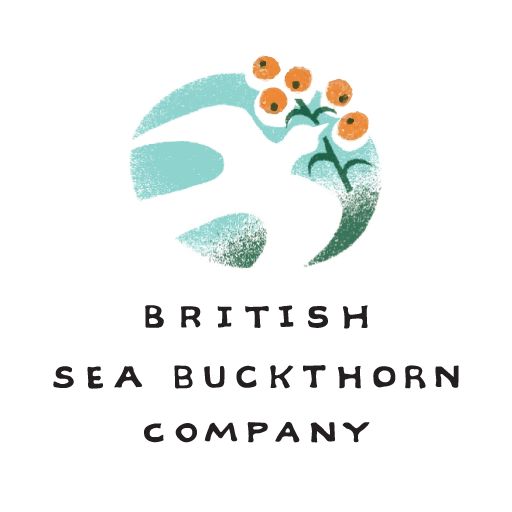Our sea buckthorn harvest this year seems to have generated a whirlwind of travelling. Maybe it was naive to consider that flying plants several thousand miles to a new growing environment was not going to create some ticklish problems, but all new enterprise is about challenge.
Harvestability is key to developing any crop. This has always been a key area for development with sea buckthorn. It has resulted in the development of whole crop branch cutting machinery in Germany and this concept is the one that we are following. This developed as the alternative to traditional handpicking.
Handpicking we tried this year, but the berries were just too small to make this viable. It is standard practice in Siberia, and Ben and I watched it last month on a farm with over 700 hectares of sea buckthorn. The secret was the pickers were dealing with large berries on very mature plants. Their berries were the size of olives. They were also being picked for oil which meant that they could be picked slightly under ripe, so they were still firm.
Our trip to Siberia has shown the shape, size, colour and taste that our Siberian varieties should look like. It has turned out that we are not the only one’s with this problem.
Last week was the biannual Euroworks workshop. This year is was in Pruszkow, Poland. It was well attended as usual with delegates from Scandinavia, central and Eastern Europe and Russia. The networking opportunity of these events is invaluable. The interest in sea buckthorn is expanding and this year Rumania was well represented indicating an impressive level of investment. This has developed out of local recognition of the health benefits of taking sea buckthorn, particularly in reducing the level of winter colds in schools.
One of the presentations on Friday was from Humboldt university doing trials on Siberian varieties like ours. As previous trials in the Baltic have resulted failed with these varieties there has been a preference to use local and German plants. The Humboldt trial cleverly looks at grafting siberian stock onto german Leikora variety rootstock. The growth rates recorded showed a significant improvement with the grafted plants as opposed to whole Siberian plants.
The issue that has been recorded however is small berries – just like ours. This factor was also confirmed in some trial plants being grown in Greece.
Siberian plants have a number of advantages over European – thornless, berries with natural sugars that reduce the traditional sour taste, but large berries are a key characteristic.
I had the opportunity to have long discussions with sea buckthorn agronomists from Sweden and Germany and clearly we need to take a scientific approach to solving this problem. It could be an issue of maturity of plants, but this is unlikely to be the driving factor. Our use of foliar feeds, irrigation, soil type, soil fertility are all variables that may adjust berry size back to normal.
Ambient temperature always was going to be an issue. The cold winters in Siberia are a factor, but the fact that we have had some long dry periods may be causing some changes in characteristics. I have noticed a secondary pollination producing a few green berries in late August. This has also been noted in Greece. It has been suggested that this is a response to both heat and dry conditions making the plant feel it has been through a false dormancy.
The result of all this means we need to design a trial, measuring the impact on yield and plant growth of different levels of foliar feeds, composts and irrigation. I am hopeful that we will find a UK horticultural or agricultural institute to help in the trials and well as linking ours with the work being done in Humboldt.
These trials will be an ideal focus to then monitor and analyse the impact of branch cutting as a harvesting method. The German harvest system cuts all the branches of a plant using a large mechanical harvester. Berries grow on last year’s wood, so this method means that the plant takes three years to regrow sufficiently between crops. It is efficient and economical but means that you need three times as many plants as you would do if you picked every year.
An alternative would be to just cut one third of the branches on each bush. This will be our way forward. It raises the problem though of encouraging the principle pest of sea buckthorn – the sea buckthorn fly – Rhagoletis batava. This has the capacity to damage up to half the crop. It has been found in Germany in 2013/14 having migrated across from Asia. Our trials need to also look to finding ways of designing a growing and harvesting process that offers a minimum of fruit to the fly when it is active.
Trials are part of the process of developing a crop, but we have also to make the whole project here at Devereux farm viable. Next year we have to produce a crop and develop it into a product. Euroworks provided an insight into new sea buckthorn product developments in Europe. An EU funded project, investigating how extracts from sea buckthorn leaves can inhibit the harmful impacts of the consumption of red meat. The results of this project coming to fruition next March. Another presentation focused on Allantoin, a phtyochemical that is being isolated as providing the rapid wound healing properties long recognised as a sea buckthorn property. Work on the presence of natural serotonin in the bark of sea buckthorn progresses. Research both from Russia and Germany is focusing on extraction techniques. One of the long term objectives of the sea buckthorn industry has been to find value in the complete plant – the fruit, leaves and wood. Sea buckthorn has long been recognised for its health benefits – the work on allantoin and serotonin are both specific examples of where developing this perennial, sustainable crop is taking us.
